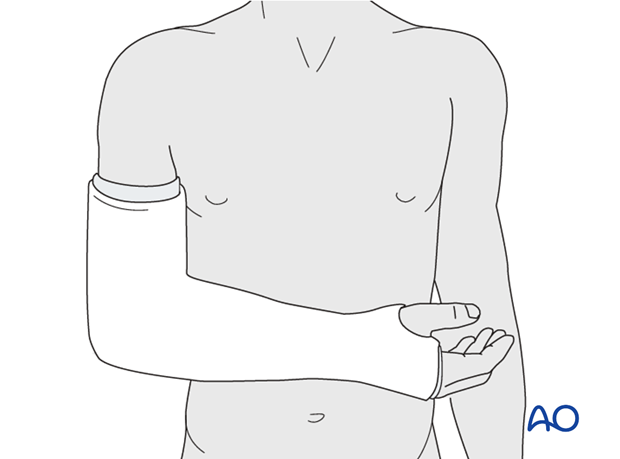Nonoperative treatment
1. Treatment considerations
The only adult forearm shaft fractures in which a satisfactory functional outcome can be expected after nonoperative treatment are minimally displaced or stably reduced, isolated ulnar fractures with no compromise of either radioulnar joint. According to Sarmiento et al, the more proximal the level of the fracture the higher the risk of impaired pronation.
See:
- Mackay D, Wood L, Rangan A (2000) The treatment of isolated ulnar fractures in adults: a systematic review. Injury; 31(8):565-70.
- Sarmiento A, Latta LL, Zych G, et al (1998) Isolated ulnar shaft fractures treated with functional braces. J Orthop Trauma; 12(6):420-3; discussion 423-4.
- Handoll HH, Pearce P (2009) Interventions for isolated diaphyseal fractures of the ulna in adults. Cochrane Database Syst Rev; Jul 8;(3):CD000523.
The basic principles of nonoperative treatment of ulnar shaft fractures are:
1) The wrist joint must be included in the cast: some surgeons also prefer to include the elbow in the cast
Note: The citations quoted suggest that, in these fractures, an above elbow cast may not be necessary.

2) If the elbow joint is included in the cast, it should be in 90° flexion
3) The cast should be well-padded and split along its whole length in any injury where progressive swelling is to be expected.
Sarmiento and Latta ( Closed Functional Treatment of Fractures, Springer Verlag, 1981, p.384) recommend that the cast be applied with the arm suspended from Chinese fingers traps and the elbow at a right angle. This results in a forearm posture of "relaxed supination": they combine this with careful moulding anteroposteriorly in such a manner as to separate the two bones and tension the interosseous membrane.

4) The cast should not extend beyond the proximal palmar flexor crease, in order to permit full flexion of the MCP joints of the fingers.
5) The thumb should not be included in the cast.

Meticulous clinical observation for compartment syndrome must be undertaken. Watch out for increasing inappropriate pain, especially with passive stretching of the muscles of the affected compartment(s).

2. Aftercare following nonoperative treatment
Extension and flexion of the fingers
Start with finger exercises immediately after casting.
Maintain elevation of the limb for 24 hours, paying special attention to pain, especially with passive extension and flexion to the fingers, which could indicate compartment syndrome.

Broad arm sling
A broad arm sling is used to support the weight of the cast for the first 7-10 days.
It is advisable to practice active elbow extension exercises out of the sling on a regular basis if a short arm cast is being used.
The position of the ulnar fracture should be checked radiographically at 1 week and 2 weeks after the onset of treatment. Should the fracture position become unacceptable, compression plating is indicated.

Functional bracing
In minimally displaced ulnar fractures which have been treated nonoperatively and which have not displaced on follow-up x-rays, functional bracing might be considered after 3 weeks, as a means of enhancing wrist rehabilitation.














